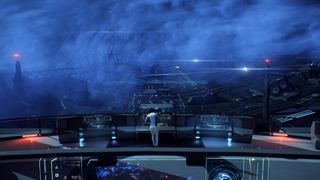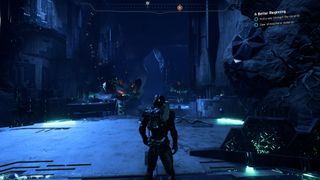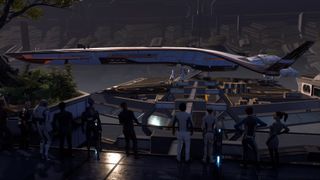Exploring The New Frontier In 'Mass Effect: Andromeda,' Hands-On

With Commander Shepard’s story wrapped up in the original Mass Effect trilogy, Bioware pushed forward on a new installment in the series that takes place long after the events around Shepard and his crew. The result is Mass Effect: Andromeda, a game that’s supposed to mark a new chapter not just for the studio, but for players, as well. For many veterans of the series, including myself, the new game featured many similarities to its predecessors, which provided some familiar ground to work with in the new adventure. After 20 hours of play time, there are so many things to do, and yet I feel like I barely scratched the surface.
Uncharted Worlds
The journey from the Milky Way to the new Andromeda Galaxy took a long time, even with advanced technology. My character woke up after a 600-year cryo-induced sleep, and in the opening hours of the game, the responsibility of Pathfinder passed on to me. The job required me to find new planets that were ripe for colonization. In addition, I had to deal with new alien species--some of which were welcoming and some that were aggressive and posed a dangerous threat.
These new worlds had diverse environments, and they provided large spaces to explore. For instance, the planet Eos is desert-like. Large bugs walked the surface, and towering pillars of rock dotted the landscape. Other worlds had lush vegetation, dangerous lightning strikes, or featured a desolate tundra. In all of these locations, I encountered nature fighting back in the form of dangerous radiation levels, freezing temperatures, or hostile creatures. To counteract this, I deployed small forward stations at specified locations to provide additional health, ammo, or life support time to further explore the area. In some situations, I had access to a new vehicle called the Nomad. It’s no Mako (the vehicle from the first Mass Effect game), but the six-wheeled transport traversed most terrain with ease. I even used it to mine for resources as I scoured the planet’s surface.
In order to find a new home for the colonists, I needed to raise a planet’s Viability rating through quests. At 40% Viability, you can establish an outpost base--an important stepping stone for colonization. There’s also the overall Andromeda Viability meter, which increases based on the number of planets scanned, major foes defeated, or completed story-based missions, and the more points it accrued, the more people came out of cryo-sleep and settled in outposts. Based on how I allocated the settlers’ priorities (Science, Military, or Technology) I gained rewards and bonuses throughout the game.

Quests range from finding lost information caches to investigating strange structures to simply eliminating hostile aliens. On my playthrough, it didn’t take long for me to build up a massive number of missions to the point where I could spend a few hours completing them and not advance the story at all.
Between missions, there were plenty of activities to do, such as research and development for new weapons, armor, and mods. Both aspects of item creation require multiple ingredients, which you get from minerals, (which you can find by scanning planets or mining for resources) or components (which are found in containers in the wild or through fallen creatures and enemies). However, I also needed a specific number of research points when I was learning to create a new item. I obtained said points by using the new scanning tool. You can scan strange generators, towering obelisks, and even new flora and fauna for research points, so it’s worth performing a quick scan of your surroundings once every few minutes.
There was also a plethora of characters to talk to throughout my journey. Aside from long conversations with crewmates aboard the Tempest (the new ship), many characters provided additional lore and information. There were even more details on the Mass Effect universe within the Codex section in the main menu for lore-hungry players.
Stay on the Cutting Edge
Join the experts who read Tom's Hardware for the inside track on enthusiast PC tech news — and have for over 25 years. We'll send breaking news and in-depth reviews of CPUs, GPUs, AI, maker hardware and more straight to your inbox.
First Contact
For those who played Mass Effect 3, the combat system in this game should be familiar, although it has some changes. Once again, Bioware focused most of the gameplay on fast-paced, intense combat. You can use up to three abilities in the field, as well as an array of weapons at your disposal. Instead of rolling around to dodge attacks, there are now “jump-jets” on your back, which allows you to evade attacks, quickly dash towards enemies, or briefly hover in mid-air to rain damage from above.
You can still command your two compatriots to move to a location or attack a specific enemy, but the developers removed the ability to tell them to use specific abilities. In previous games, you could open the game’s command wheel and tell your companions to use a specific ability or ammunition against different enemies. Now, you just tell them to attack an enemy, and they’ll automatically use their abilities as needed.
It seems like an “out of sight, out of mind” solution to dealing with teammates, but I actually preferred telling teammates what to do at the right time rather than have the game's A.I. take over in my stead. However, in the past it felt more tactical, but now you have limited control over your team.

There are also new changes in class-based abilities. With more combinations of abilities (because of the removal of class limitations), the sky (or in this case, galaxy) is the limit for what you can do with your character in combat. My Pathfinder was primarily a Soldier-based fighter who provided bonuses in weapon damage, but he also used biotic powers to throw enemies in the air or toss them across a room. There’s also the ability to set different “Profiles” so you can switch between four ability combinations to suit different scenarios. However, I didn’t really utilize the profile switches that much; I preferred to stick to one set of abilities with my teammates’ own skills to complement my combat style.
This made combat a mixed bag. The ability to combine even more abilities was fantastic, but at times it felt as if I was a one-person army. With the right abilities on hand, it was easy to take down one foe while teammates thinned out the rest of the enemy herd. It made for some intense situations, to be sure, but it was sometimes so chaotic that it was hard to determine who was shooting at what foe. At some point, I was forced to just take out whatever was in my view and move on to another target. There was no real teamwork at play.
The Shortcomings
Even though Mass Effect: Andromeda has many favorable elements throughout, there were a few things that needed some work. This is the first game in the series that used DICE’s Frostbite Engine (in the past, Bioware used the Unreal Engine), although Bioware used it previously in another game, Dragon Age: Inquisition. In some ways, this game shows Bioware’s experience with the software, especially with its environments, which were beautiful. However, a quick look at any of the game’s characters showed the developers’ shortcomings. The lack of most facial expressions aside from the occasional smile or scowl was disappointing. In fact, it seems as if Bioware merely imported the facial animation from Mass Effect 2 or 3, which was disheartening when you consider the technological advancements in development since the last game came out in 2012.
I was also not a fan of the new way the Tempest moved around the larger system and galaxy maps. It’s this prolonged, first-person animation of zooming out from a starting point and then traveling to the destination, before it zooms in again on the destination planet. The entire process seemed slow and boring. I get that it’s supposed to imply this feeling of exploring a new universe, but it felt like a step back in the way I was supposed to interact with each new planet or anomaly.
There were also glitches in animation and quests that made the experience frustrating. Sometimes my character was stuck in a position or stumbled awkwardly as he moved forward. Some quests also didn’t register into the journal, which made it harder to keep track of the things to do in each area. I prefer to leave no stone unturned when it comes to quests, and this bug made that infuriating.
The Trail We Blaze
Nevertheless, Mass Effect: Andromeda has captured my attention for now, at least. My quest log continues to grow, and the story of the Pathfinder’s first steps in the galaxy is just beginning to unravel. Each planet I landed on provided plenty of space to explore, characters to interact with, and quests to complete. Even with my gripes against the combat and graphical shortcomings, I’m willing to see the game through to the end. There are more unexplored worlds and unforeseen dangers waiting somewhere in the Pathfinder’s new home, and I have to meet them head-on to give people a second chance at a new life.
| Name | Mass Effect: Andromeda |
|---|---|
| Type | RPG, Sci-Fi, Third-Person Shooter |
| Developer | BioWare |
| Publisher | EA |
| Platform | PC, PlayStation 4, Xbox One |
| Where To Buy | OriginPlayStation StoreXbox StoreAmazonBest BuyTargetWalmartGameStop |
| Release Date | March 21, 2017 |
-
problematiq Mass effect 1-3 "We need to ban together to defend against this invading enemy!" Mass Effect:andro "Invade all the planets!!"Reply
Most Popular



